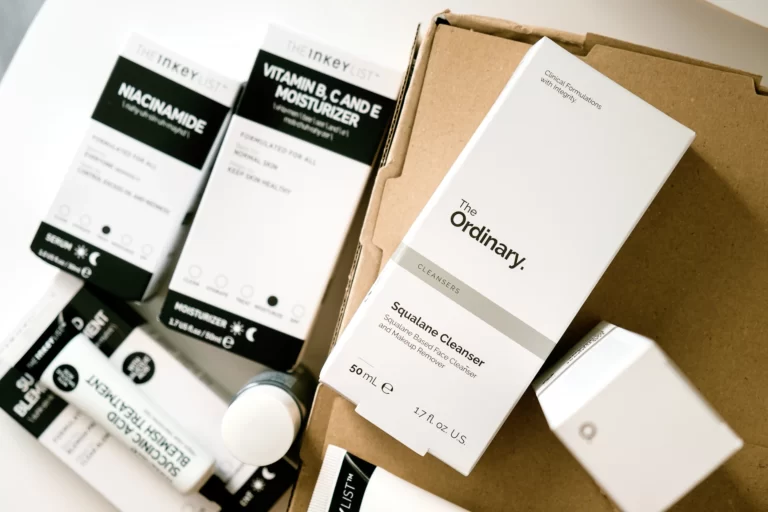Can You Mix Benzoyl Peroxide and Niacinamide Together? For those struggling with acne and in need of an effective solution, there’s promising news for you! Have you thought about including both benzoyl peroxide and niacinamide in your skincare regimen?
These two ingredients, when used together, can be a game-changer for acne-prone skin. Not only does benzoyl peroxide help clear up blemishes, but niacinamide helps hydrate the skin and prevent any dryness caused by benzoyl peroxide.
So, let’s dive into the topic and find out how you can incorporate these two power ingredients into your skincare routine.
Table of Contents
Can I Use Benzoyl Peroxide with Niacinamide?
Absolutely! In fact, using benzoyl peroxide and niacinamide together can be a powerful combination for treating acne-prone skin.
As I mentioned earlier, benzoyl peroxide is great at killing the bacteria that cause acne and unclogging the pores, while niacinamide helps regulate oil production and improve skin barrier function.
And here’s the thing, benzoyl peroxide can also be drying and irritating to the skin, which is where niacinamide can help. By using these two ingredients together, you can help clear up your acne while also keeping your skin hydrated and healthy-looking.
The Most Recommended 7 Skincare Ingredients

Notice: There are products that are even more popular, but these are my personal favorites which have helped me a lot.
- Retinol: Retinol is a form of Vitamin A that can help boost collagen production, unclog pores, and reduce the appearance of fine lines and wrinkles.
- Hyaluronic Acid: It is a natural substance found in our skin that can hold up to 1000 times its weight in water. This makes it a great ingredient for keeping your skin hydrated and plump.
- Vitamin C: Vitamin C is a powerful antioxidant that can help brighten and even out your skin tone. It also helps to protect your skin from damage caused by free radicals.
- Witch Hazel: Witch hazel is a natural astringent that can help soothe and calm irritated skin. It’s also a great ingredient for those with oily skin, as it can help control excess oil production.
- Niacinamide: Also known as Vitamin B3, niacinamide can help improve the barrier function of your skin, reducing the appearance of redness and strengthening your skin’s natural barrier against moisture loss.
- Ceramides: Ceramides are lipids (fats) that are naturally found in our skin and play a crucial role in keeping our skin hydrated and protected. Adding ceramides to your skincare routine can help reinforce your skin’s natural barrier and keep your skin feeling soft and smooth.
- Centella Asiatica: Also known as Gotu Kola, this herb has been used in traditional medicine for centuries. It has been shown to help soothe irritated skin and reduce the appearance of redness and dark circles.
I hope these ingredients can help you choose the right products for your skin type and concerns!
Understanding Niacinamide
Benefits
Niacinamide, also known as vitamin B3, is a potent skincare ingredient that has gained popularity for its wide range of benefits. Here’s what you need to know about this multitasking hero:
- Improved Skin Barrier: Niacinamide helps strengthen the skin barrier, reducing water loss and enhancing moisture retention. This makes it ideal for all skin types, especially those with dry or sensitive skin.
- Minimized Pores: If you struggle with enlarged pores, niacinamide can be your savior. It regulates oil production, leading to visibly reduced pore size over time.
- Brightened Complexion: Say goodbye to dull skin! Niacinamide effectively reduces the appearance of dark spots and hyperpigmentation, promoting a brighter and more even complexion.
- Reduced Fine Lines: This wonder ingredient has antioxidant properties that combat free radicals, ultimately diminishing the appearance of fine lines and wrinkles.
- Calmed Inflammation: Niacinamide’s anti-inflammatory properties soothe redness and irritation, making it an excellent choice for individuals with acne-prone or sensitive skin.
Pro Tip: To maximize the benefits of niacinamide, incorporate it into your skincare routine as a serum or moisturizer after cleansing and toning
As someone with combination skin and occasional breakouts, niacinamide has been a game-changer for me. It has helped balance my skin’s oil production, leading to fewer breakouts and a more even skin tone. Also, my skin feels smoother and looks brighter since introducing niacinamide into my routine.
Possible Side Effects
While niacinamide is generally well-tolerated by most individuals, some people may experience mild side effects, including:
- Skin Irritation: In rare cases, niacinamide may cause mild irritation or redness, especially if used in high concentrations or combined with other active ingredients.
- Allergic Reactions: Individuals with a known allergy to niacinamide or vitamin B3 may experience allergic reactions, such as itching, hives, or swelling.
- Dryness: Niacinamide’s oil-regulating properties could lead to excessive dryness in some individuals, particularly if not followed by proper moisturization.
- Peeling: In certain cases, niacinamide may cause mild peeling, especially when used in combination with other exfoliating products.
It’s essential to conduct a patch test before incorporating niacinamide into your skincare routine, especially if you have sensitive skin or a history of allergies. If you experience severe or persistent side effects, discontinue use and consult a dermatologist.
Understanding Benzoyl Peroxide
Benefits of Benzoyl Peroxide
Benzoyl Peroxide is a powerful topical medication widely used to combat acne. Here’s a straightforward rundown of this acne-fighting hero:
- Bacteria Fighter: Benzoyl Peroxide effectively kills acne-causing bacteria on the skin’s surface, reducing inflammation and preventing new breakouts.
- Unclogs Pores: This ingredient works by penetrating the pores and loosening clogs, helping to clear blackheads and whiteheads.
- Reduces Excess Oil: Benzoyl Peroxide regulates sebum production, keeping the skin’s oiliness in check and preventing greasy buildup.
- Minimizes Inflammation: It calms redness and swelling associated with acne, promoting a more even complexion.
- OTC or Prescription Strength: Benzoyl Peroxide is available in various strengths, from over-the-counter formulations to prescription options for severe cases.
Been doing benzoyl peroxide cleaner, and moisturizer and the rest is Korean skin care and baby all them steps worth it because it works
— ♥️ Nico (Burna Boy Stan) (@ThinkImBigNeek) July 29, 2023
Remember: Start with a lower concentration of benzoyl peroxide (2.5% or 5%) to minimize potential skin irritation. Gradually increase the concentration if needed, but always follow the recommended usage and consult a dermatologist if unsure
I struggled a lot with acne in my teenage years, and benzoyl peroxide helped me a lot. I started with a gentle 2.5% formulation, which significantly reduced my breakouts over time. In the beginning, I used too high a concentration, which made my skin very dry.
However, with a light moisturizer, the problem was quickly solved. Today, benzoyl peroxide is a staple in my skincare routine, making my skin clearer and more confident.
Potential Side Effects
- Skin Dryness: Benzoyl peroxide can cause dryness and peeling, especially when first starting or using higher concentrations.
- Irritation: Some individuals may experience redness, itching, or stinging at the application site.
- Sensitivity: Benzoyl peroxide may increase skin sensitivity to sunlight, leading to a higher risk of sunburn.
- Allergic Reactions: In rare cases, individuals may develop allergic reactions, including rash or hives.
- Bleaching of Fabrics: Benzoyl peroxide may bleach clothing, towels, or hair if not completely dry before contact.
It is essential to follow the product’s instructions and start with a lower concentration to minimize potential side effects. Conduct a patch test before using it all over the face to check for any adverse reactions. If you experience severe or persistent side effects, discontinue use and consult a healthcare professional or dermatologist.
The Effectiveness of Benzoyl Peroxide and Niacinamide

Benzoyl peroxide and niacinamide are both popular ingredients in skin care products for treating acne.
Benzoyl peroxide works by killing the bacteria that cause acne and unclogging the pores. Niacinamide, on the other hand, helps regulate oil production and improve skin barrier function, which can help prevent acne from forming in the first place.
Studies have shown that the combination of benzoyl peroxide and niacinamide can be an effective way to treat acne. The combination helps to clear up existing blemishes and prevent new ones from forming, resulting in a clearer and healthier-looking complexion.
It’s important to note that while benzoyl peroxide is a powerful ingredient, it can also be drying and irritating to the skin. By adding niacinamide to the mix, you can help counteract these drying effects and soothe the skin.
The Importance of Hydrating Ingredients
You know, your skin is delicate and can easily become dehydrated, especially if you’re using acne-fighting ingredients like benzoyl peroxide. That’s why it’s so important to use hydrating ingredients to help keep your skin nourished and moisturized.
Benzoyl peroxide can be a bit drying, as it can strip your skin of its natural oils. When this happens, your skin can become flaky, tight, and even irritated. And that’s not what we want, right? That’s where niacinamide comes in. Niacinamide is a great hydrating ingredient that can help soothe and hydrate the skin, while also improving its barrier function.
And it’s not just niacinamide that you can use to hydrate your skin. There are other ingredients that can help too, like hyaluronic acid, which can hold up to 1000 times its weight in water. And when you use these ingredients along with benzoyl peroxide, you can help keep your skin looking and feeling soft, smooth, and hydrated.
Mixing Benzoyl Peroxide and Niacinamide

Here’s what you need to know about mixing these two ingredients:
- Start slow: If you’re new to using benzoyl peroxide, start by using a lower concentration, such as 2.5% or 5%, and gradually increase to a higher concentration if needed. The same goes for niacinamide – start with a lower concentration and work your way up as your skin adjusts.
- Apply separately: It’s best to apply benzoyl peroxide and niacinamide separately, rather than mixing them together. Apply the benzoyl peroxide first, then wait a few minutes before applying the niacinamide. This will help ensure that each ingredient can fully penetrate the skin and do its job.
- Use a moisturizer: It’s important to use a good moisturizer when using benzoyl peroxide, as it can be a bit drying. Look for a moisturizer that contains niacinamide or hyaluronic acid, as these ingredients will help hydrate the skin and prevent dryness.
- Give it time: As with any skincare routine, it takes time to see results. Be patient and give the combination of benzoyl peroxide and niacinamide time to work. You may not see immediate results, but with consistent use, you should start to see a clearer, healthier-looking complexion.
Do I use niacinamide before or after benzoyl peroxide?
I recommend you apply benzoyl peroxide first, followed by niacinamide. In this way, niacinamide can provide antioxidant protection to vitamin E-depleted skin.
Can I use benzoyl peroxide after niacinamide Serum?
Yes, you can use benzoyl peroxide after niacinamide serum. In fact, combining these two ingredients can help with skin problems like excessive oiliness and inflammation. Because benzoyl peroxide can cause irritation and dryness, it should be combined with a hydrating ingredient such as niacinamide or hyaluronic acid.
What can you not mix with benzoyl peroxide?
Retinol, vitamin C, AHA, BHA, and other benzoyl peroxide acne products should not be combined. It works well with moisturizing ingredients like hyaluronic acid, ceramides, and rosehip oil.
What should you not mix with niacinamide?
Niacinamide and vitamin C should not be combined. Both are antioxidants that are commonly found in skincare products, but they should not be used concurrently. Furthermore, niacinamide should not be combined with acidic skincare ingredients such as AHAs/BHAs and vitamin C. While some experts argue that mixing them will not harm you, it is still a hotly debated topic in the skincare community.
Is benzoyl peroxide or niacinamide better for acne?
For mild to moderate facial acne, combining benzoyl peroxide and niacinamide is more effective than using either one alone. Studies have shown that combining 2.5% benzoyl peroxide and 5% niacinamide improves acne more than either ingredient alone.
Does niacinamide make acne worse before better?
Niacinamide is unlikely to cause purging because it does not affect the skin in the way that purging usually does. Because niacinamide does not stimulate cell turnover, any signs of purging appear as inflammatory acne-like pustules or cysts.
What serum can I use with benzoyl peroxide?
Serums containing hyaluronic acid, ceramides, and rosehip oil are all suitable for use with benzoyl peroxide. However, using multiple benzoyl peroxide products at the same time is not advised.
How long does it take for niacinamide to clear acne?
Most studies indicate that using niacinamide to treat acne takes 6-12 weeks to see results. The first benefits may be seen in two weeks, but the majority of results will be seen in four weeks or more.
If you liked this blog article about the question: Can I Use Benzoyl Peroxide with Niacinamide, don’t forget to leave us a comment down below to tell us about your experience with these two ingredients.





